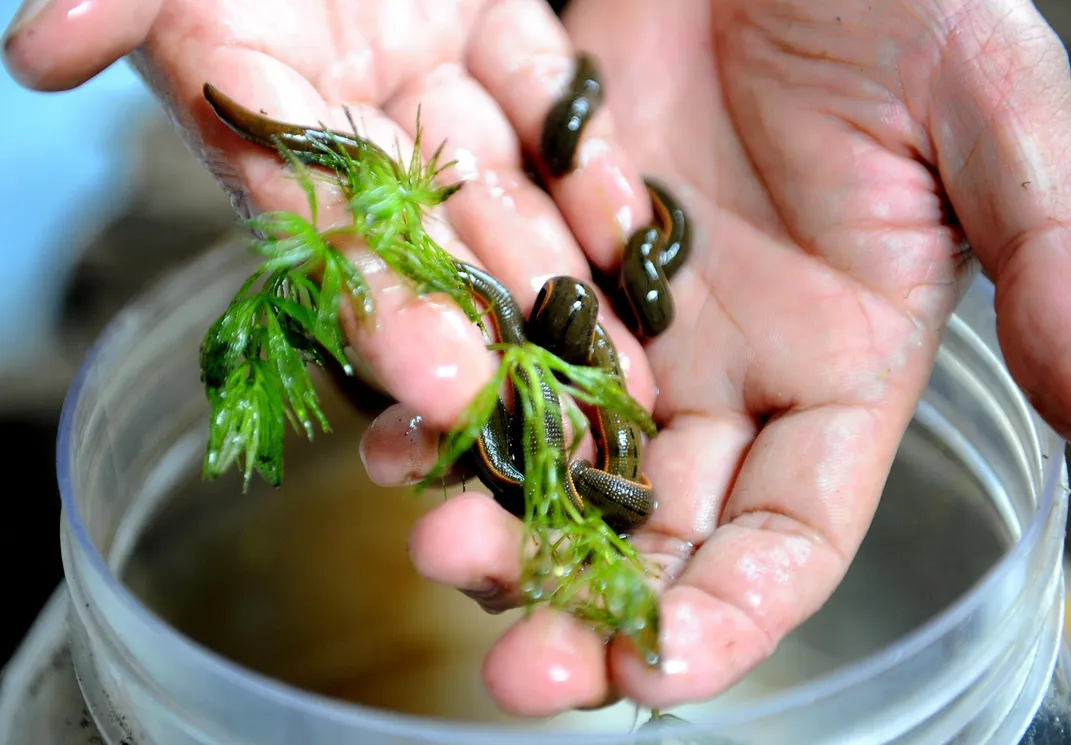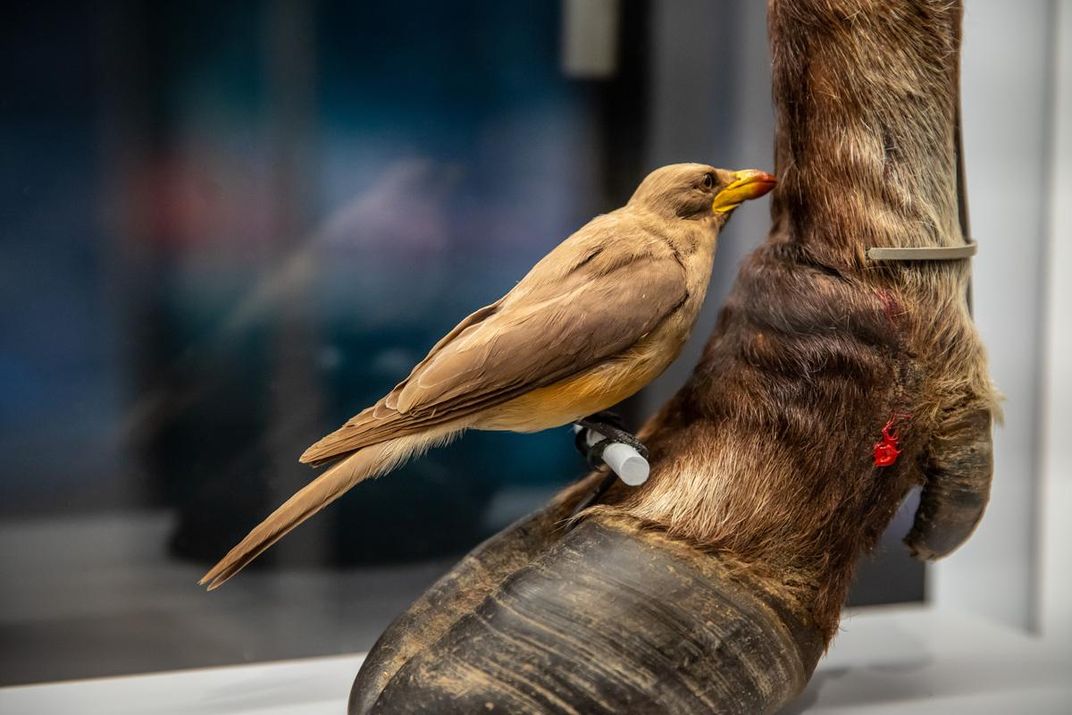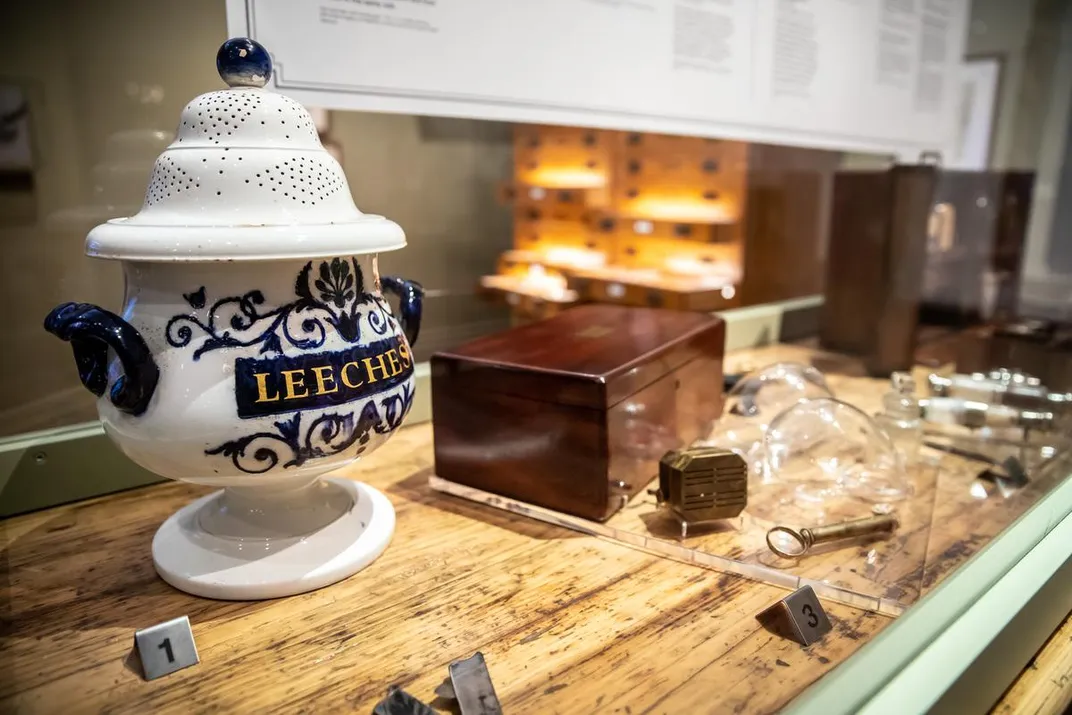Why the World Needs Bloodsucking Creatures
The ecological benefits of animals like leeches, ticks and vampire bats are the focus of a new exhibition at the Royal Ontario Museum
/https://tf-cmsv2-smithsonianmag-media.s3.amazonaws.com/filer/79/c0/79c04c90-b5f2-43ec-a8d3-c4c92a54da56/sea_lamprey_mouth_credit_t_lawrence_great_lakes_fishery_commission.jpg)
In a sprawling gallery of the Royal Ontario Museum, curators and technicians crowded around two large coolers that had recently arrived at the Toronto institution. Wriggling inside the containers were live sea lampreys, eel-like creatures that feed by clamping onto the bodies of other fish, puncturing through their skin with tooth-lined tongues, and sucking out their victims’ blood and bodily fluids. Staff members, their hands protected with gloves, carefully lifted one of the lampreys and plopped it into a tall tank. It slithered through the water, tapping on the glass walls with its gaping mouth, rings of fearsome teeth on full view.
Having explored its new environment, the lamprey settled onto the pebbles at the bottom of the tank. It will remain on display until March as part of a new exhibition exploring the oft-reviled critters that bite, pierce, scrape and saw their way through flesh to access their favorite food source: blood.
The exhibition, called “Bloodsuckers,” includes displays of other live animals—mosquitoes, ticks and leeches—interspersed throughout the gallery. And dozens of preserved specimens, arrayed down a long, curving wall, offer a glimpse into the diverse world of the roughly 30,000 species of bloodthirsty organisms across the globe. Among these critters are vampire moths, which can pierce the thick skins of buffalo and elephants. Vampire snails target sick and dying fish, making for easier prey. The oxpecker birds of Africa pluck ticks and other insects off large mammals—and then slurp blood from their hosts’ sores.
Sebastian Kvist, curator of invertebrates at the Royal Ontario Museum and co-curator of the exhibition, knows that these animals are likely to make some visitors shudder. But to him, blood-feeders are the loveliest of organisms, the result of a refined evolutionary process. Leeches are a particular favorite of Kvist’s, and his research focuses on the evolution of blood-feeding behavior, or hematophagy, in these predatory worms. Sometimes he even affectionately lets the leeches in his lab gorge themselves on his blood.
“When you have live animals in your care, they demand some respect,” he says. “I think that it is giving back to the leech what we're getting from them to donate our warm blood.”

“Bloodsuckers” opens in a corridor bathed in red light, where an installation featuring three strands of red blood cells dangles from the ceiling. Blood is a hugely abundant food source, so it makes sense that wherever vertebrates exist, animals would arise to steal their life-sustaining fluids. Blood-feeding likely evolved repeatedly over the course of our planet’s history—“perhaps as many as 100 times,” according to Kvist. Bloodsucking creatures have no common ancestor, as the behavior has cropped up independently in birds, bats, insects, fish and other animal groups—a testament to its evolutionary value.
“I can think of no other system that’s [so] intricate that has evolved separately,” Kvist says. “And it makes blood-feeding as a behavior even more beautiful.”
Subsisting on a blood-heavy diet is tricky, however, and relatively few creatures have managed to retain this ability over time. “Thirty thousand [bloodsuckers] out of the roughly 1.5 or 1.6 million species [of animals] that have been described is a very, very small number,” Kvist says. “But it turns out that being able to feed on blood puts tremendous strain on your physiology, on your morphology, and on your behavior.”
For one, blood lacks B vitamins, which all animals require to convert food into energy. Many bloodsuckers thus host microscopic bacteria inside their bodies to provide these essential nutrients. Because blood is so iron-rich, it’s toxic to most animals in large amounts, but habitual blood-feeders have evolved to break it down.

Getting to the blood of a living creature is no mean feat either. Blood-feeding organisms have different ways of accessing their preferred snack. Mosquitoes, for instance, pierce the skin with their long, thin mouthparts, while certain biting flies boast serrated jaws that slash through flesh. But all of these methods risk being met with a deft swat from the host. To counteract this problem, some blood-feeders, like leeches, have mild anesthetics in their saliva, which help them go unnoticed as they feed. Certain creatures like vampire bats, lampreys and leeches also produce anticoagulants to keep their victims’ blood flowing, sometimes even after they’re done eating.
“A leech feeds five times its body weight in blood, up to ten times sometimes,” Kvist says. “If that blood congealed or clotted inside its body, then the leech would fall to the bottom [of the water] like a brick.”
Kvist and Doug Currie, the Royal Ontario Museum’s senior curator of entomology and co-curator of the exhibition, hope museum visitors gain a newfound appreciation for the elegance of bloodsucking organisms. Humans share a long and complicated relationship with blood-feeders. Leeches, for instance, were once seen as a life-saving force, and are in fact still used by medical experts today after certain types of surgery that overfull parts of the body with blood. But at the same time, we are unnerved by creatures that steal blood—a wariness that has persisted for centuries, as suggested by the fearsome bloodsuckers that populate folklore traditions around the world.
A natural history and culture institution, the Royal Ontario Museum also explores how blood-feeding, a trait that exists in nature, has crept into the human imagination and morphed into something fantastical. Monsters abound within the gallery. There are models of the chupacabra, a beast rumored to drain livestock of their blood, and the yara-ma-yha-who, which originated in the oral traditions of Australia and boasts blood suckers on its fingers and toes.
These creatures do not directly resemble any real blood-feeding animal. Instead, they speak to our “innate fear of something taking our life force,” says Courtney Murfin, the interpretive planner who worked with curators to craft the exhibition’s narrative.
Dracula, arguably the most famous of all the fictional bloodsuckers, may have a more tangible connection to the natural world. Legends of vampires predate Bram Stoker’s 1897 novel—visitors can see a first edition copy of the book at the exhibition—but the notion that these undead beings could transform into bats originated with Dracula. Vampire bats, which live in Mexico and Central and South America, feed on the blood of mammals and birds. They were first described in 1810 and documented by Charles Darwin in 1839. The animals may have influenced Stoker’s supernatural count.
Depictions of vampires in today’s popular culture run the gamut from cool to sexy to goofy. We can have fun with them now, Murfin says, because we know they aren’t real. But when vampire lore arose in eastern Europe in the early 1700s, the beasts were a source of true terror. Confusion about normal traits observed in decomposing bodies, like swollen stomachs and blood in the mouth, led to the belief that corpses could rise from their graves to feast on the blood of the living.
“They started digging up graves and staking the people to the ground … so they couldn't stand up at night,” Kvist says.
Fears about losing their blood to vampires did not, however, dampen Europeans’ enthusiasm for bloodletting, an age-old medical practice that sometimes involved applying leeches to the skin. The treatment can be traced back to the ancient world, where it arose from the belief that draining blood helped rebalance the body’s humors: blood, phlegm, yellow bile and black bile. Bloodletting reached its peak in the late 18th and early 19th centuries, when a “leech mania” swept across Europe and America. Pharmacies stored the critters in ornate jars—one is on display at the museum—and Hirudo medicinalis, or the European medicinal leech, was harvested to the brink of extinction.

Bloodletters also had other ways of getting the job done. One corner of the exhibition is packed with a grisly assortment of artificial bloodletting tools: scarificators, which, with the push of a lever, released multiple blades for opening up the skin; glass cups that were heated and suctioned onto the skin, drawing blood to the surface; smelling salts, in case the procedure proved a bit too overwhelming for the patient.
While medical professionals no longer believe that leeching can cure everything from skin diseases to dental woes, leeches are still valued in medicine today. Hirudin, the anticoagulant in leech saliva, is unrivalled in its strength, according to Kvist. It’s synthesized in labs and given to patients in pills and topological creams to treat deep vein thrombosis and prevent strokes. Leeches themselves make appearances in hospitals. They’re helpful to doctors who perform skin grafts or reattachments of fingers, toes and other extremities. Newly stitched arteries heal more quickly than veins, so blood that is being pumped into the reattached area doesn’t flow back into the body, which can in turn prevent healing.
“Stick a leech on, and it will relieve that congestion of the veins,” says Kvist, who also studies the evolution of anticoagulants in leeches.
Earlier this year, Kvist received a call from Parks Canada asking for help with an unusual conundrum. A man had been apprehended at Toronto’s Pearson International Airport with nearly 4,800 live leeches packed into his carry-on luggage, and officials needed help identifying the critters. Kvist took a look at some of the leeches, which appeared to have been smuggled from Russia, and pinpointed them as Hirudo verbana. Because they are threatened by over-harvesting, this species is listed by the Convention on International Trade in Endangered Species of Wild Flora and Fauna, meaning it cannot be transported without a permit. Just what the man was doing with the bloodsuckers is unclear, but Kvist says he claimed to sell them for “New Age medicinal purposes.”
“There is a larger-than-we-think underground network of people that use leeches to treat a variety of ailments,” Kvist says. The Royal Ontario Museum took in around 300 of the contraband critters, and a few dozen are presently lounging in a display tank at “Bloodsuckers.”
While leeches have long been valued for their healing properties—scientifically valid or otherwise—some bloodsuckers are better known for their ability to transmit serious illnesses. Certain species of mosquito, for instance, spread West Nile, Zika and malaria. Ticks transmit Lyme disease. The exhibition does not shy away from exploring the dangers associated with blood-feeders, and it offers advice on how to protect yourself from infection.
/https://tf-cmsv2-smithsonianmag-media.s3.amazonaws.com/filer/cf/9a/cf9ad2ac-1c36-4699-8436-a3b52e2ef4dd/ezgifcom-resize_19.jpg)
“Some fears are real,” Kvist says. “Disease, unfortunately, is a necessary consequence of blood-feeding.”
Most blood-feeding animals, though, do not pose a serious threat to humans. In fact, bloodsuckers are vital to the health of our planet. Mosquitoes are an important food source for birds. Fish eat leeches. Even sea lampreys, which are invasive to the Great Lakes, can bring essential nutrients to the aquatic habitats where they spawn. And like all species, blood-feeders contribute to the Earth’s biodiversity—a richness of life that is fast declining due to factors like pollution, climate change and habitat degradation.
Many, many animal groups need to be part of conversations regarding biodiversity, Kvist says, but he and his colleagues opted to spotlight the bloodthirsty ones. The museum hopes to help visitors feel more comfortable living alongside these animals—even if they aren’t willing to volunteer an arm for a leech’s next meal.


